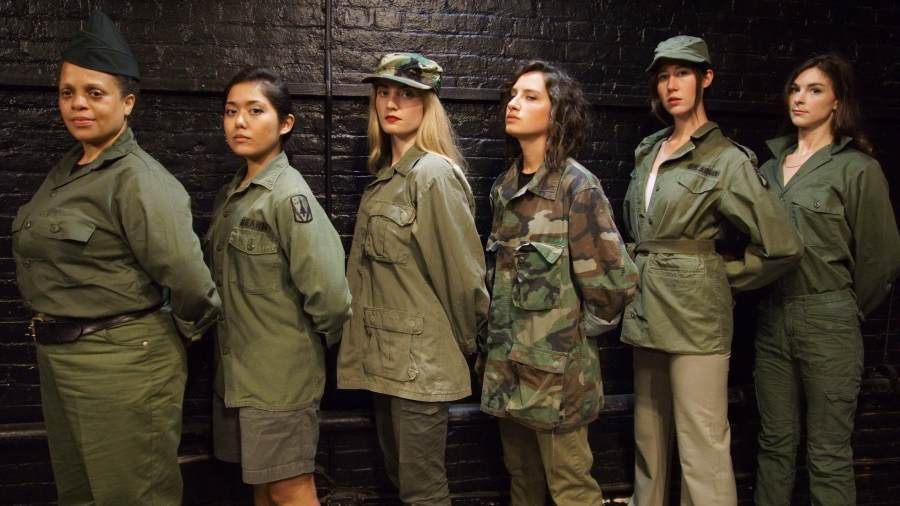

Produced by the Onomatopoeia Theatre Company and directed by Thomas R. Gordon, Shirley Lauro's award-winning play A Piece of My Heart about six women serving in the Vietnam War, is playing in the East Village from now until, aptly, Veterans Day. The Vietnam Veterans Association recently named A Piece of My Heart "the most enduring play on Vietnam in the nation."
Lauro's work, inspired by Keith Walk's oral compilation of 26 women's memoirs of serving in the Vietnam War, centers around six different women, five of whom are nurses and one who is a singer sent to entertain the troops as part of the USO. The play shows each woman right before she enters her service and throughout the Vietnam War in Act 1, and her life afterwards in Act 2. Indeed, each act could have been a play unto itself, there was so much detail to take in.
Martha (Molly-Ann Nordin), Sissy (Annabelle Mayock), Whitney (Isabel Lodge), LeeAnn (Vanessa Rappa) and Steele (Jeaniene Green) are the nurses, only one (Green) of whom has had any work or real life experience before coming to Vietnam. LeeAnn in particular is blindsided when she realizes she has been sent to Vietnam when she requested Hawaii (where everyone looks like her -- having grown up Chinese and Italian and surrounded by prejudice in NYC). All of the nurses realize there is no time to panic or even to train, as they have to attend to droves of dying men immediately.
When they return to the USA, they all have difficulty fitting back into so-called real life, and are treated as if their years of service did not happen, if not being spit on by war protestors. Many of the nurses are questioned about their ability, even sent to a remedial CPR course. Steele is offered the exact same desk job she left three years prior, with "Still and all" as the reason, leaving the audience to echo her in asking "Still and all WHAT???"
As the singer, Mary Jo is part of the group, though under different circumstances, never more clear when her agent cheats her out of her pay when she returns to the USA. Eliza McKelway's musical ability with her voice and guitar is impressive, and her entire demeanor is evocative of the folk singers of the era. Her post-war life is also marred by post-traumatic stress disorder, to the point where she cannot even go shopping for jeans.
The cast is rounded out by Justy Kosek and Marcus Kirlew, skillfully playing all of the men in the play. In fact, all of the actors segue in and out of other characters without minimal costume changes, but instead with changes in voice and mannerisms, and in lighting and sound. This combination of acting and tech made it easy to keep track of the story.
Al Malonga's costume design is on-point with the different styles of the 1960s and 1970s, and her costuming of Kosek and Kirlew when they play various injured and dying men is incredible. Between the acting and the costumes, I actually believed Kosek had no legs and that half of Kirlew's face was missing.
The play touches on all the myriad aspects of the Vietnam War, even having Rappa play a Vietnamese woman whom one of the nurses hires as a housekeeper. We hear this woman's stoic acceptance that her eight-year-old son was shot dead by a soldier, as she still comes to work. The American nurses cry on her behalf. It is an interesting reminder that different cultures face their tragedies in different manners, but it does not mean one is more feeling than the other. Lauro also includes a harrowing description of the long-term effects of Agent Orange (the defoliant chemical used to get rid of leaves on trees so Vietcong could not hide in the woods, and whose latent effects in the human body is still evident in veterans and in citizens throughout Vietnam to this day).
Her inclusion of the stories of LeeAnn and Steele is particularly important as it was only in recent years that veterans of color have been depicted at all, and even more rare are the stories of women of color in the military. When Steele presents important data predicting the deadly Tet Offensive, her male superiors dismissively shove it under the rug, leading to thousands of killed soldiers later.
All in all, this is an important piece detailing what cannot be absorbed in a history book, if military women's stories are in it at all.